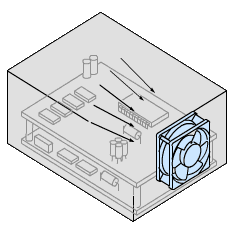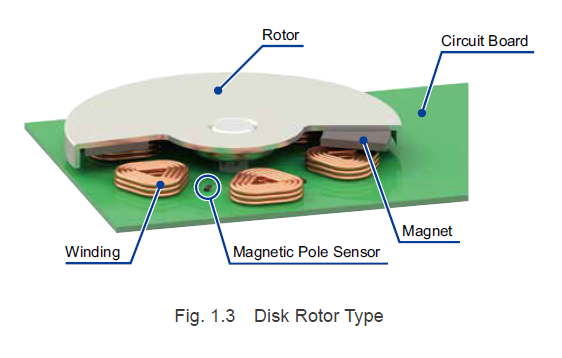This is part 1 of the Technical Manual Series for brushless motors, which explains the three main types of brushless motors: inner rotor type, outer rotor type, and disk rotor type.
Brushless motors combine permanent magnets, windings, magnetic pole sensors, and a drive circuit to perform the function of a motor. This type of motor is excellent in terms of speed controllability and energy conservation. Compared to using inverters and firing angle control to control the speed of induction motors, these motors can be used at a wide range of speeds, from low speed rotation to high speed rotation. In addition, permanent magnets are used in the rotor, and because there is no need to induce current into the rotor as with induction motors, brushless DC motors are compact and offer high output power and efficiency.
However, brushless DC motors were traditionally expensive and had limited applications due to the requirement for permanent magnets in the rotor, magnetic pole sensor, and a dedicated drive circuit.
In recent years, the development of electronic devices along with increased integration of electronic parts has reduced both the cost and size of drive circuits. Moreover, because the demand for energy conservation has increased in order to address global warming, brushless DC motors have become widely used in energy-saving appliances such as air conditioners, refrigerators, and washing machines, as well as in drive motors and on-vehicle electric motors for electric cars and hybrid cars. Their compact size and high output power have allowed them to be used for a wide variety of applications,
including cooling fans for touch-screen panel computers, disk drive devices, and drones.
Since there are few structural design limitations for brushless motors, several designs have been developed. We will explain the characteristics offered by the three most typical designs.
Types of Brushless Motors
| 1.1 Inner Rotor Type |
For the "inner rotor" type, the rotating component, AKA the rotor, is located inside the stator, and a segmented permanent magnet is installed on the outer surface of the rotor. Due to a small rotor diameter and a low moment of inertia, it provides excellent acceleration and deceleration responsiveness. In addition, because the stator position is close to the motor surface, there is good heat radiation, allowing for a compact motor with high output power.

This is the typical configuration for brushless motors, and they are used for a wide variety of purposes. In my opinion, they can be great space savers or high efficiency options for material handling applications, such as driving the pulleys for conveyors and/or driving the wheels of AGVs.
| 1.2 Outer Rotor Type |
With the "outer rotor" type, the rotor is located outside of the stator, and the permanent magnet is located inside the rotor. The segmented permanent magnet is now installed on the inner surface of the rotor. The locations of the stator and the permanent magnets are opposite of the inner rotor type. A cup-shaped rotor is not well-suited to nimble movements because the moment of inertia is larger, and the acceleration and deceleration responsiveness are poor, but it still provides excellent speed stability.
Because the rotor diameter is large, more magnets can be installed than with the inner rotor type, which increases the number of magnetic poles when compared to the inner rotor type. This makes high output power possible in a compact size. However, because the windings are located in the interior and heat radiation is poor, the windings heat up easily, which limits operating time. In drone motors that use an outer rotor type brushless motor, the rotor cup is equipped with ventilation holes, and the wind generated by the propellers helps to keep the windings cool.

Applications for the outer rotor type are narrower. The larger inertia of the rotor makes it more difficult to start and stop quickly. The poor heat radiation properties limits operation time. However, if the motor design takes heat ventilation, radiation, or cooling into consideration, then the applications can extend to cooling fans and drones, for example.
| Enclosure Ventilation (Axial Flow Fan) |
 |
| 1.3 Disk Rotor Type |
For the "disk rotor" type, the stator is formed by mounting the windings and magnetic pole sensors on the circuit board. Because the tabular permanent magnets are located on the rotor surface so that they face the stator, this type of motor is thin. It is used to maintain a stable, fixed speed with a light load. There is no shaft, so the load is installed to the rotor.

This type of motor is generally used in hard disk drives and disk drives for CVDs, Blu-ray discs, and other media, but it could extend to other applications where space is a constraint. Unfortunately, Oriental Motor does not offer any of the disk rotor type brushless motors, but our brushless motors are designed to be shorter than the competition. We do offer flat type stepper motors (42/60 mm frame sizes) for positioning or indexing applications.
Oriental Motor's inner rotor type brushless motors are designed for speed control applications. Contact our team to learn more!
In the next part of this Technical Manual - Brushless Motor Series, we will explain brushed DC motors. Please subscribe to this blog to be notified of future posts!
Interested in learning more?
Learn more about Oriental Motor's 
Subscribe (top right corner) to receive monthly updates!





